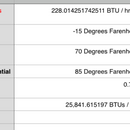Heat loss calculation for a ductless system
I did a thorough whole house heat loss calculation for my project when I was considering doing radiant floor heat but I have now decided to go with a Ductless Mini Split system. On one of the final tables of my spreadsheet (where I calculate design day requirements), I seem to have put in a “Boiler Efficiency” factor most likely for the heat source for the water for the hydronics. When it comes to sizing the outdoor units, should I leave that final adjustment? I attached a picture of the table showing the data. All I have read about the outdoor units suggests that they should be sized very closely with one’s requirements so I am thinking this last calculation is not going to be valid for a MSP outdoor unit. Any thoughts? The good news is that my spreadsheet does have all the correct dimensions, areas, material specifications (U-Factors) and infiltration calculations. I just want to make sure the coldest day requirement doesn’t come up short.
Thanks in advance.
GBA Detail Library
A collection of one thousand construction details organized by climate and house part










Replies
John,
Can you please define "my spreadsheet"? Is this a spreadsheet you created, or is it a heat loss calculation spreadsheet that you purchased or found online for free?
The table you displayed makes clear that this spreadsheet was developed for people who are designing a hydronic system equipped with a boiler. If you are designing a heating system based on air-source heat pumps, boiler efficiency is obviously irrelevant.
Most load calculators don't calculate the input-BTUs of the boiler, which is the only reason to include the boiler's efficiency number. If you insert 100% efficiency into the efficeincy parameter it should come up with the actual load number.
A 99% outside design temperature of -15F is colder than the capacity tables reach for most ductless heat pumps. While they are still delivering useful heat at that temperature, the manufacturer won't specify & guarantee a number. But there are many that have rated capacities at -5F, and you can do a bit of extrapolation to estimate the delivery @ -15F. If you up-size from the -5F capacity by 25% you'll be covered.
Note: Mitsubishi's cold climate mini-splits turn off at some low temp to self-protect operation due to potential sensor errors below -18F. That's the coldest temp that they will guarantee that it will still run, though there have been field reports of them still working at temps of -20F or a few degrees cooler. When they turn off due to the out of low-temp range error they automatically re-start once is warms up to -13F. If you regularly see temperaures in the -20s F it's probably wise to go with another vendor.
Hi Martin,
I made my own spreadsheet after reading James Kachadorian's "The Passive Solar House" (Chelsea Green). Sadly, the local library is way behind on good technical books since the good ones are mostly trade-oriented and expensive. There probably aren't too many people interested in reading books these days but that's just my opinion. That being said, I think I put that calculation/allowance in there after doing research about how to size a boiler for a radiant application (and wanting to avoid the dreaded short cycle condition that can happen with oversized equipment).
Thanks Dana for pointing out that I am pushing the limits with most systems. I will plan on having some kind of a backup for those extreme days. I always thought "design temperature" meant the most extreme temperature the system will most likely see. I know I am pushing the limits but I'd rather put money into the building envelope. Also, my indoor temperature of 70 is probably a bit high (I'm sure I'd be fine if the house were 60).
Indoor & outdoor design temperatures used by HVAC & building designers are typically either the 99th percentile or 99.6th percential temperature bin on the hourly temperature history at the location over multiple decades. The 99th percentile temperature at which 99% of the hours in a year are that warm or warmer, and only 1% are colder. So if the 99% outside design temp is -15F, 87 hours in a typical year are colder than -15F.
If one specifies a heating system that delivers EXACTLY the amount of heat needed to cover the 99% heat load, there is going to be a few times per decade where the interior temp might drop below your specified indoor temperature, but excursions below the 99th percentile bin are usually brief in duration, and the amount it drops below depends on the duration of the colder temperature, how much colder, and the thermal mass of everything inside the house. Some amount of auxiliary heating such as a pack of sled dogs or throwing an all night polka party with a dozen 200lb Czechs can usually make up the difference. ;-)
Thanks for the clarification Dana. I've been talking to the Mitsubishi guys since meeting them at NESEA. I do like your idea of sled dogs for backup heat! My original idea (long since jettisoned) was a masonry heater but with your idea, I could just let the dogs outside once it hit zero. :)